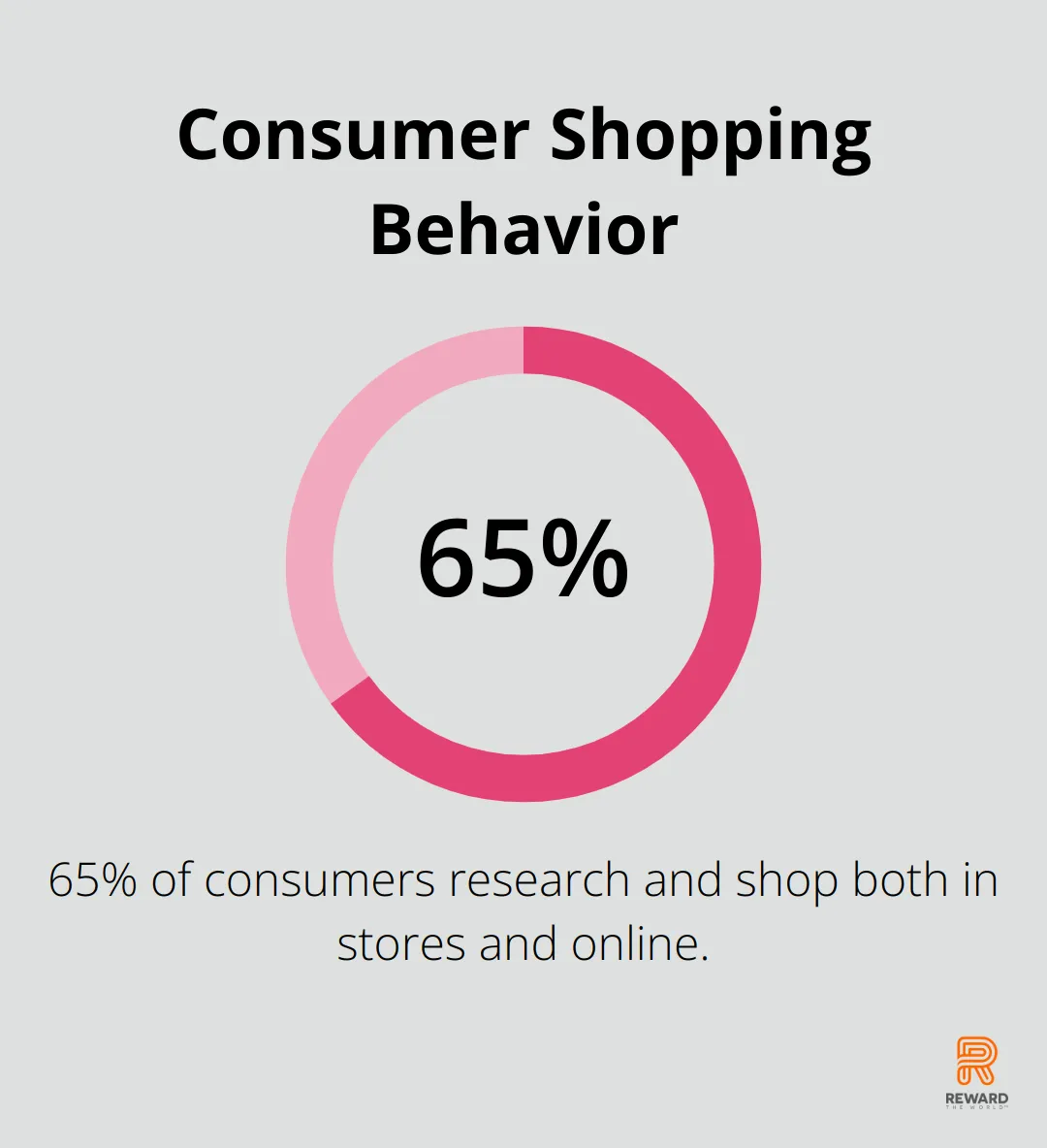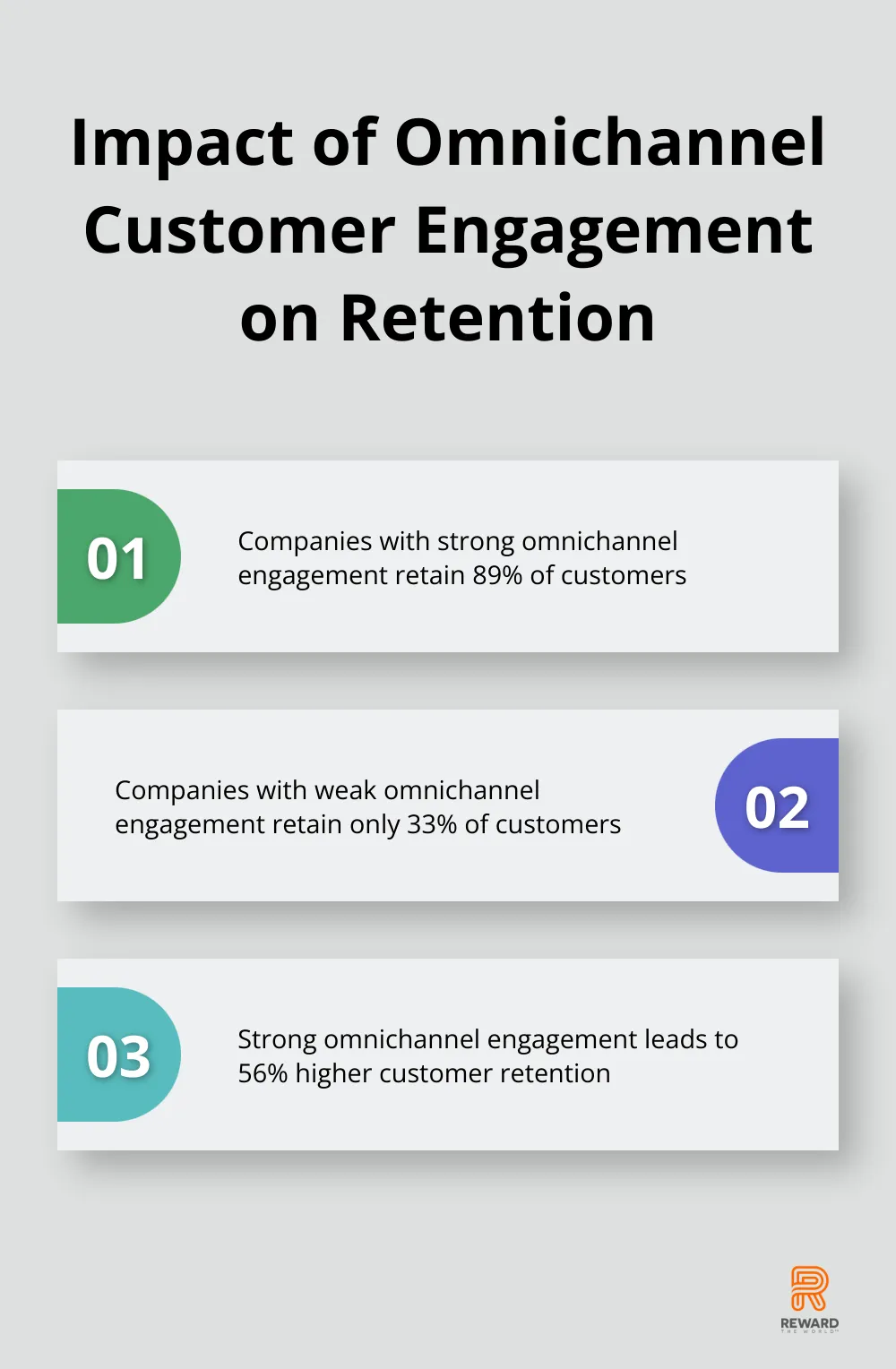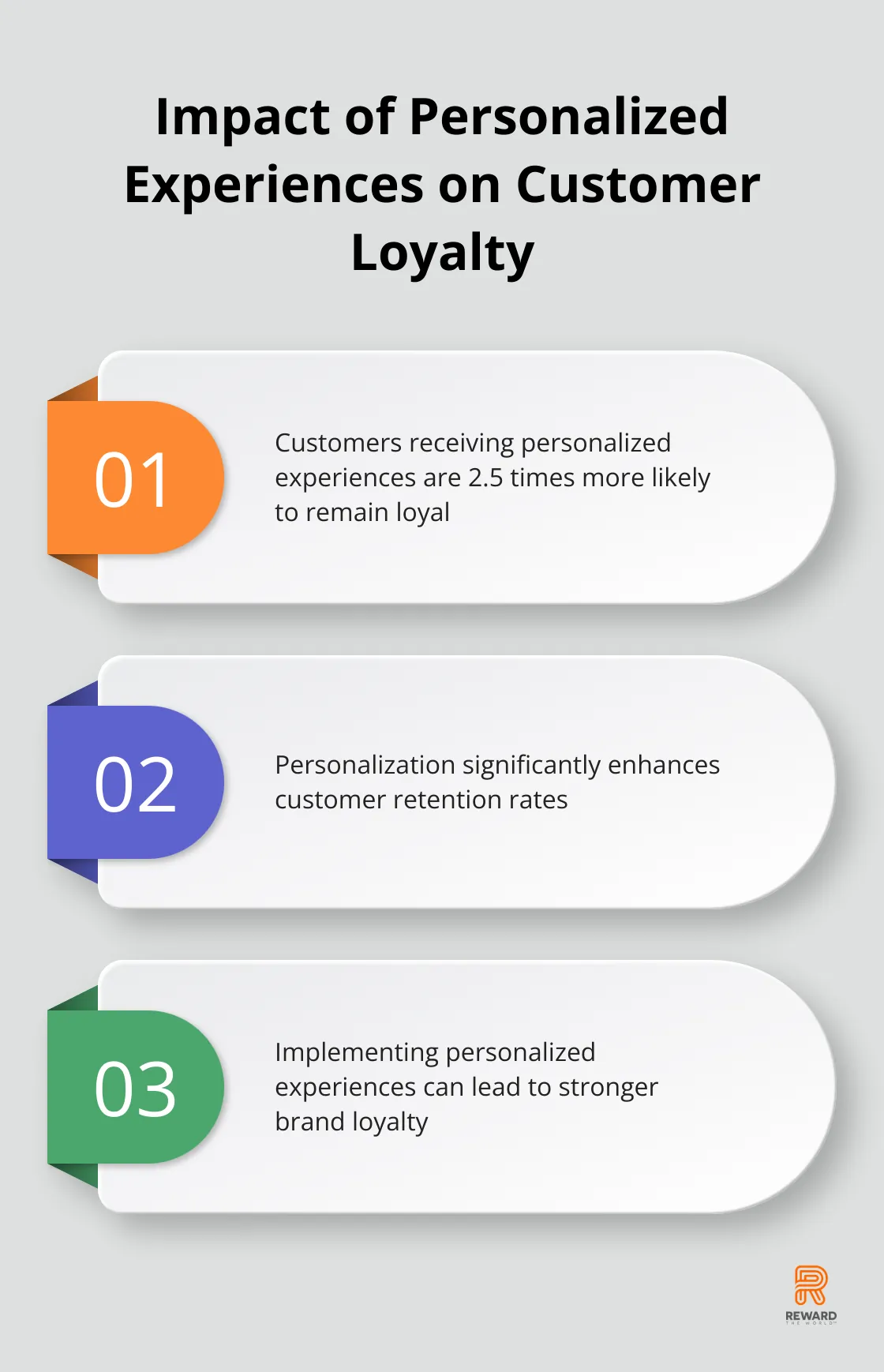
At Reward the World, we’ve seen firsthand how omnichannel rewards are reshaping customer loyalty programs.
Today’s consumers expect seamless experiences across all touchpoints, from in-store to online and mobile.
Businesses that master omnichannel rewards can boost engagement, increase customer lifetime value, and gain a competitive edge in the market.
In this post, we’ll explore strategies for implementing effective omnichannel reward programs and overcoming common challenges.
Why Omnichannel Rewards Matter
The Necessity of Ubiquitous Rewards
Omnichannel rewards have become essential in today’s interconnected retail landscape. Customers now expect a seamless experience across all touchpoints, whether they shop in-store, online, or through a mobile app.
About 60 to 70 percent of consumers research and shop both in stores and online. This hybrid shopping behavior underscores the need for rewards programs that work everywhere. When customers can earn and redeem rewards regardless of their chosen channel, it creates a frictionless experience that encourages repeat business.

Building Trust Through Consistency
A consistent brand experience across all channels plays a vital role in building trust and loyalty. According to Forrester, 90% of customers expect consistent interactions across channels. However, only one-third of businesses manage to maintain that consistency. This gap presents a significant opportunity for companies to stand out by offering a unified rewards experience.
Driving Tangible Business Results
Omnichannel reward programs don’t just please customers-they drive concrete business outcomes. Analysts estimate that purchase and engagement rates are 250% higher for customers experiencing an omnichannel journey. This statistic alone should motivate any business to invest in a comprehensive rewards strategy.
The Virtuous Cycle of Engagement
An effective omnichannel rewards program creates a virtuous cycle of engagement. Customers who can easily access and use their rewards are more likely to:
- Make repeat purchases
- Recommend the brand to others
- Provide valuable feedback
This increased engagement leads to higher customer lifetime value and a stronger competitive position in the market.
Overcoming Implementation Challenges
While the benefits of omnichannel rewards are clear, implementation can pose challenges. It requires a strategic approach, the right technology, and a commitment to continuous improvement. (Some businesses might find these hurdles daunting, but the potential rewards far outweigh the initial difficulties.)
In the next section, we’ll explore practical strategies for implementing an effective omnichannel rewards program that meets the needs of today’s consumers. These strategies will help businesses navigate the complexities of omnichannel rewards and create a program that truly resonates with their customer base.
How to Build an Effective Omnichannel Rewards Strategy
Unify Your Data Infrastructure
The foundation of any successful omnichannel rewards program is a unified data infrastructure. This requires the integration of point-of-sale systems, e-commerce platforms, mobile apps, and customer relationship management (CRM) tools. Companies with extremely strong omnichannel customer engagement retain on average 89% of their customers, compared to 33% for companies with weak omnichannel customer engagement.

To achieve this, start with an audit of your current systems. Identify any silos or gaps in data flow between channels. Then, invest in a centralized customer data platform (CDP) that can collect and synthesize information from all touchpoints. This will provide a single, comprehensive view of each customer’s interactions and preferences.
Personalize Rewards Based on Customer Behavior
Once you have a unified view of your customers, use this data to personalize rewards. Personalization in marketing and advertising is becoming increasingly important for consumers. This goes beyond using a customer’s name in emails; it means tailoring rewards to their specific behaviors and preferences.
For example, if a customer frequently shops for athletic wear in-store but buys accessories online, you could offer them a special discount on a new line of sports gear that they can redeem either online or in-store. For a customer who often browses but rarely purchases, you might offer a loyalty point bonus for making their next purchase, regardless of the channel they choose.
Leverage Mobile Technology for Seamless Access
Mobile technology is the linchpin of a truly omnichannel rewards program. A comprehensive consumer study on loyalty and credit card programs provides insights into consumer preferences for engaging with loyalty programs. Your mobile app should serve as a hub for your rewards program, allowing customers to:
- Check their points balance
- Redeem rewards
- Receive personalized offers
- Make purchases
- Access customer support
Ensure your app integrates with in-store systems, allowing for easy point redemption at the register. Consider features like mobile wallet integration or QR code scanning to bridge the gap between digital and physical shopping experiences.
Implement Real-Time Reward Updates
Nothing frustrates customers more than outdated or inconsistent reward information. Implement a system that updates reward balances and available offers in real-time across all channels. This might involve investing in API-driven architecture that can quickly sync data between your mobile app, website, and in-store systems.
For instance, if a customer makes a purchase in-store, their updated points balance should immediately reflect when they check their account on their smartphone or computer. This real-time consistency builds trust and encourages continued engagement with your rewards program.
Train Your Staff on Omnichannel Rewards
Your employees are the face of your rewards program, especially in physical locations. Invest in comprehensive training to ensure they can assist customers with rewards across all channels. This includes:
- Understanding how to look up customer reward balances
- Assisting with point redemption in-store and online
- Explaining how rewards can be earned and used across different channels
- Troubleshooting common issues
Well-trained staff can significantly enhance the customer experience.
The implementation of an effective omnichannel strategy requires continuous measurement and optimization. Set clear KPIs for your program, such as cross-channel engagement rates, reward redemption rates, customer lifetime value, and Net Promoter Score (NPS). Regular analysis of these metrics will help identify areas for improvement.
As you build your omnichannel rewards program, consider partnering with a platform like Reward the World. With its global reach and extensive reward options, it can provide the technological backbone needed to create a truly seamless rewards experience across all touchpoints. The next section will explore common challenges businesses face when implementing omnichannel reward programs and strategies to overcome them.
Navigating Omnichannel Reward Challenges
Synchronizing Data Across Channels
Data consistency forms the foundation of a successful omnichannel rewards program. Inconsistent information across channels can frustrate customers and lead to missed opportunities. To address this:
- Implement a centralized data management system as a single source of truth for all customer interactions and rewards.
- Use real-time data syncing technologies to update information instantly across all touchpoints.
- Regularly audit your data for discrepancies and set up automated alerts for any inconsistencies.
- Invest in robust API integrations to allow seamless data flow between your various systems and platforms.
Forrester’s 2023 Customer Experience Index shows that customers receiving personalized experiences are 2.5 times more likely to remain loyal to a brand.

Streamlining Inventory and Fulfillment
Managing inventory and fulfillment across multiple channels presents complexities, especially for physical rewards. Try these strategies to streamline the process:
- Implement an integrated inventory management system for real-time visibility across all channels.
- Use predictive analytics to forecast demand and optimize stock levels (this can reduce stockouts or overstocking).
- Partner with fulfillment services that specialize in omnichannel operations to manage reward distribution logistics more efficiently.
- Leverage digital rewards where possible. eGift cards and digital experiences allow instant fulfillment, reducing complexity.
According to McKinsey analysis, logistics costs currently represent 12 to 20 percent of e-commerce revenues, and this figure is likely to continue to grow.
Ensuring Consistent Staff Training
Your staff represent the face of your rewards program. Their ability to provide consistent experiences across all touchpoints is vital. Equip them well with these strategies:
- Develop comprehensive training programs covering all aspects of your omnichannel rewards system, including technical knowledge and customer service skills.
- Create easily accessible reference materials, such as digital handbooks or mobile apps, for staff to quickly consult during customer interactions.
- Implement regular refresher courses and updates to keep staff informed about new features or changes in the rewards program.
- Use role-playing exercises to simulate various customer scenarios, helping staff practice handling different situations across channels.
- Consider a mentorship program where experienced staff guide newer employees in navigating omnichannel rewards complexities.
Online research by Aberdeen Group shows that companies with strong Omnichannel strategies retain an average of 89% of their customers in comparison to 33% for companies with weak Omnichannel strategies.
Choosing the Right Technology Partner
Selecting the appropriate technology platform is critical for a successful omnichannel rewards program. Look for a partner that offers:
- Seamless integration capabilities with your existing systems
- Robust analytics and reporting features
- Scalability to grow with your business
- Strong security measures to protect customer data
Customer engagement platforms stand out as a top choice in this regard, offering comprehensive solutions that address these needs and more.
Measuring and Optimizing Performance
To ensure your omnichannel rewards program delivers results:
- Set clear Key Performance Indicators (KPIs) such as cross-channel engagement rates and reward redemption rates
- Regularly analyze these metrics to identify areas for improvement
- Conduct customer surveys to gather feedback on the program’s effectiveness
- Use A/B testing to optimize reward offerings and user experiences across channels
Final Thoughts
Omnichannel rewards have become essential for successful customer loyalty strategies in today’s interconnected retail landscape. Businesses that provide seamless experiences across all touchpoints can boost engagement, increase customer lifetime value, and gain a competitive edge in the market. Customers who easily access and use their rewards across channels make repeat purchases, recommend the brand, and provide valuable feedback.
Successful implementation of omnichannel rewards requires a strategic approach. Companies must unify data infrastructure, personalize rewards based on customer behavior, leverage mobile technology, implement real-time updates, and train staff thoroughly. Overcoming challenges such as data synchronization, inventory management, and consistent staff training creates a truly seamless experience.
The importance of omnichannel rewards will only grow as customers expect personalized, frictionless experiences across all touchpoints. Reward the World offers a comprehensive solution for companies looking to elevate their customer engagement and boost performance. With its global reach, extensive reward options, and seamless integration capabilities, it provides the technological backbone needed to create an effective omnichannel rewards experience.
